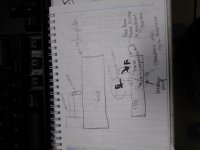i am seriously considering starting combination mill lathe machine using surface plate as the base
i will be using through hole not the insert types.
the major question i have on my mind for two weeks now...
how much force would it take to literally break 8cm~10cm surface plate in half
for compressive strength on the net 200MPA, and this source says 2100 MPA (Granite :: MakeItFrom.com)
2100 MPA i really dont believe that... that's very strong
so.... how do i factor in thickness, kg/cm2 i can figure out
maybe use the cross sectional area (thickness) to punch in the numbers?
so for example 40x60x8 (cm) surface plate has 8x40 or 8x60 cross sectional area so.. 320cm2, 480cm2
what force should i use?
tensile strength?
shear?
i am guessing tensile
so tensile strength of granite is 25~39MPA (according to different sources)
320x25 320x39, 480x25, 480x39
8000~12480 MPA, 12000~18720 MPA
815773 ~ 127260.58 kg, 122365.95 ~ 191196.79 kg
the figures seems pretty weird to me.. waaaaaay too high
because i've been utube vids where a dude uses sledge hammer to break boulders in half lol, although it takes lots of hits
one thing though machining forces may locally applied so that may drive down the actual figures...
i'd be happy with even 1/20 the amount indicated above..
it would easily machine 1045 steels, which is my ultimate objective right now
am i calculating right? can some one help me out here
i will be using through hole not the insert types.
the major question i have on my mind for two weeks now...
how much force would it take to literally break 8cm~10cm surface plate in half
for compressive strength on the net 200MPA, and this source says 2100 MPA (Granite :: MakeItFrom.com)
2100 MPA i really dont believe that... that's very strong
so.... how do i factor in thickness, kg/cm2 i can figure out
maybe use the cross sectional area (thickness) to punch in the numbers?
so for example 40x60x8 (cm) surface plate has 8x40 or 8x60 cross sectional area so.. 320cm2, 480cm2
what force should i use?
tensile strength?
shear?
i am guessing tensile
so tensile strength of granite is 25~39MPA (according to different sources)
320x25 320x39, 480x25, 480x39
8000~12480 MPA, 12000~18720 MPA
815773 ~ 127260.58 kg, 122365.95 ~ 191196.79 kg
the figures seems pretty weird to me.. waaaaaay too high
because i've been utube vids where a dude uses sledge hammer to break boulders in half lol, although it takes lots of hits
one thing though machining forces may locally applied so that may drive down the actual figures...
i'd be happy with even 1/20 the amount indicated above..
it would easily machine 1045 steels, which is my ultimate objective right now
am i calculating right? can some one help me out here



